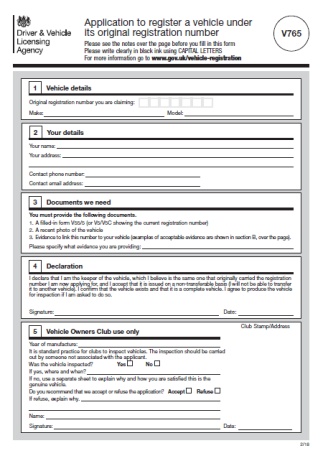Risks
with sending original classic car documents to DVLA
Experience with V765 applications
The V8 Register has undertaken three detailed vehicle inspections
with its findings set out in a thorough report to support a member's
V765 application. The MG Car Club is accepted by DVLA as a Vehicle
Owners Club able to carry out the necessary detailed research and
inspection to determine the genuine status of a vehicle to support
a vehicle owner's V765 application. With specific MG models, like
the MGBGTV8, the MG Car Club uses the skills and knowledge of its
relevant Registers to carry out the detailed inspection and produce
an authoritative report to support the Club's statements in Section
5 of a form V765 application.
Form V765/1 for guidance and a list of vehicle owners clubs
See
the list on the DVLA website
Procedure carried out by Kimber House for the V756 and V55/5
MG
Car Club Guide
Posted:
191023 |
 |
What
is the DVLA form V765 procedure?
The DVLA V765 procedure enables a classic car owner to claim
an original registration number and then register a vehicle
under its original registration number when it has never been
registered at DVLA, or when it has been registered under another
age-related registration number. Any car that has been off the
road since before 1983, when the DVLA replaced its records
with a computer-based system, might not be covered by the the
registration agency's current records.
V765 application supported by a Vehicle Owners Club
In Section 5 of the form a Vehicle Owners Club has to state
whether, based on their inspection of the car and knowledge
of the model, in its view they are satisfied the vehicle is
the genuine vehicle recommend that DVLA accept or refuse the
V765 application. In making that statement the Vehicle Owners
Club has to explain why and how they are satisfied this is the
genuine vehicle. That explanation is based a detailed inspection
of the car with the inspection results set out in a report.
Section 5 requires the Vehicle Owners Club to confirm it had
inspected the car so it is able to confirm the year of manufacture,
whether the car was inspected and when, and how they were satisfied
the vehicle is a genuine vehicle. It is standard practice for
clubs acceptable to DVLA inspect vehicles. In completing Section
5, the Vehicle Owners Club has to state whether they accept
or refuse the V765 application. See
a form 765 |
What
are the risks with sending valuable original vehicle documents
to DVLA?
In a lead feature in its latest issue, Classic Car Weekly reports
"classic owners are increasingly being asked by DVLA to
send decades old and irreplaceable paperwork for their vehicle
in the post to support V765 applications". Ian Edmunds,
DVLA Liaison for the Federation of British Historic Vehicle
Clubs (FBHVC), says "it confirms a fear I have had".
Submitting these valuable original documents is part of the
V765 registration procedure - part of the process of putting
a classic car back on the road after a long period of storage".
Any original documents required by DVLA to support a V765 application
which a vehicle owner regards as valuable and irreplaceable
should only be sent to DVLA using the best quality package delivery
service to ensure security of delivery and tracking throughout.
But that's not all - original vehicle documents have to be handled
by DVLA staff and then returned to the vehicle owner.
Example of how original documents submitted to DVLA can be
damaged
With a VED exemption application, made shortly after the concession
was introduced and the procedure new to both DVLA and applicants,
a document was sent to DVLA to prove the "build date"
of an MGBGTV8 in December 1973 when the car was first registered
in June 1974. That document was a "Heritage certificate"
issued by BMHIT at Gaydon. It was sent to DVLA in a C4 sized
envelope with a stiff card backing so the pristine certificate
would not be damaged in the Royal Mail registered postal service.
That document was returned roughly folded in a standard C5 envelope
using an ordinary Royal Mail postal service, neither recorded
or registered, and its pristine condition was damaged. Not a
life threatening outcome as the document was received by the
vehicle owner but a request to reuse the C4 envelope to package
an unfolded document when returning the item was ignored by
the DVLA staff. Clearly with much rarer documents a vehicle
owner simply cannot take the risks of either damage in transit
or worse the loss of any or all of the documents during DVLA
processing or in transit. So vehicle owners need to exercise
the greatest care over sending rare documents to DVLA (possibly
via their Vehicle Owners Club) and equally important ensuring
the documents are returned safely too.
One possible way of avoiding the risk of damage or loss of valuable
original documents is have photocopies certified as a true
copy by a lawyer so the certified documents can be submitted
where required by DVLA. |
|



